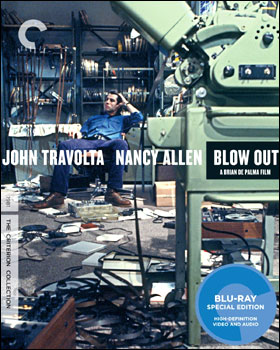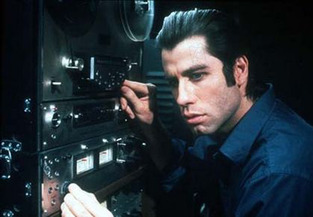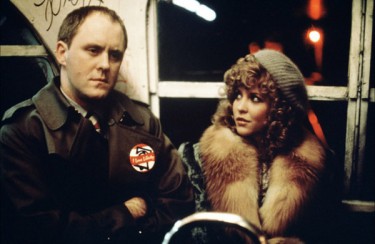 Back to selection
Back to selection
“BLOW OUT”
 The ending of Brian De Palma’s Blow Out hits you in the chest like a hammer. It’s not supposed to be this way; American studio movies don’t end like that. But of course it’s the heartbreaking denouement that has partially helped to make the film endure in the 30 intervening years since its commercially disastrous release, though one can certainly fathom how it alienated audiences at the time (for the record, some critics were passionate defenders; it’s just that most viewers don’t savor being implicated in the spectacle of violence as it is quickly transformed into tragedy). As De Palma himself has wryly observed, the studio likely just expected another erotic romp like Dressed to Kill (De Palma’s previous surprise hit for the Filmways outfit) and were unprepared for a downbeat but cinematically exhilarating last gasp of bravura filmmaking, political critique, and social cynicism that made its ’70s predecessors like The Conversation and The Parallax View seem like Oliver! by contrast. But as the greatest film ever made by one of the two or three most important filmmakers to emerge from the “New Hollywood” movement of the ’60s and ’70s, Blow Out is among the most significant films of the past three decades, and the film has been thankfully reappraised in subsequent years. Hopefully its new Criterion Collection Blu-ray and DVD special-edition release will also help to introduce it to a younger generation of film enthusiasts.
The ending of Brian De Palma’s Blow Out hits you in the chest like a hammer. It’s not supposed to be this way; American studio movies don’t end like that. But of course it’s the heartbreaking denouement that has partially helped to make the film endure in the 30 intervening years since its commercially disastrous release, though one can certainly fathom how it alienated audiences at the time (for the record, some critics were passionate defenders; it’s just that most viewers don’t savor being implicated in the spectacle of violence as it is quickly transformed into tragedy). As De Palma himself has wryly observed, the studio likely just expected another erotic romp like Dressed to Kill (De Palma’s previous surprise hit for the Filmways outfit) and were unprepared for a downbeat but cinematically exhilarating last gasp of bravura filmmaking, political critique, and social cynicism that made its ’70s predecessors like The Conversation and The Parallax View seem like Oliver! by contrast. But as the greatest film ever made by one of the two or three most important filmmakers to emerge from the “New Hollywood” movement of the ’60s and ’70s, Blow Out is among the most significant films of the past three decades, and the film has been thankfully reappraised in subsequent years. Hopefully its new Criterion Collection Blu-ray and DVD special-edition release will also help to introduce it to a younger generation of film enthusiasts.
Of course, during the ’70s (clearly, a loosely defined era in American filmmaking), challenging audience expectations — whether socio-political or purely filmic — had become rather expected, so perhaps De Palma (much like his old friend Scorsese who artistically triumphed with the similarly commercially underappreciated Raging Bull the previous year — trivia note: it was actually De Palma who first introduced Scorsese to De Niro at a party) was unaware of the post-Jaws/Star Wars shift in the new Reagan-era American cinema. But De Palma had just come off a hit with Dressed to Kill, and had also enjoyed a pop culture phenomenon with Carrie only a few years earlier; even his less financially successful genre endeavors like Obsession, Phantom of the Paradise, and Sisters hardly seemed to exist in the same unapologetically confrontational realm as some of Scorsese’s more overtly personal work. So for De Palma to embark on a violent suspense exercise — one with stars like John Travolta and De Palma’s then-wife Nancy Allen in addition — may have seemed like a relatively safe commercial bet…no matter than the film harked back to the grim and anti-authoritarian conspiracy thrillers of the decade that preceded Blow Out’s release. But for those who mistakenly believed that De Palma’s career essentially began with Sisters, the political pessimism of Blow Out might seem like an unexpected departure indeed — yet, Sisters was actually the filmmaker’s seventh feature film, and if anything, Blow Out serves as a newfound and masterful fusion of the director’s Hitchcockian tales of mayhem and perversion, with a radical political consciousness seemingly jettisoned eight years prior.
De Palma’s first six features — Murder a la Mod (included in its entirety as a supplementary feature on this Criterion disc), Greetings, The Wedding Party, Dionysus, Hi, Mom!, and Get to Know Your Rabbit — demonstrate political concerns and counterculture beliefs that would only scarcely return in his later work, sometimes with rewarding results (the underrated Casualties of War) but sometimes with ill-advised ramifications (the misguided Redacted). If De Palma discarded a playful political sensibility in favor of equally playful approaches to film technique beginning with Sisters in ‘73, Blow Out is incredibly rewarding in the way that it combines both sensibilities. Yet it would be disingenuous to imply that this is the principal factor for the movie’s enormous impact: if De Palma’s subsequent thrillers found him experimenting with form and style to the point of gleeful and unabashed self-parody (most notably in the often hilarious likes of Body Double, Femme Fatale, and — most obviously — Raising Cain), Blow Out is played comparatively “straight,” but with no less contagious joy for the medium of filmmaking. And the political backdrop provides additional narrative gravity to a story that is, above all else, a genuinely melancholy and heartfelt tale of doomed love and shattered political idealism.
 Travolta — still delivering his best performance to date — plays Jack, a soundman on low-budget horror B-movies for a small Philadelphia production company (as has often been remarked, the schlocky slasher opus Coed Frenzy that opens the film, with a somewhat improbably elaborate single Steadicam shot courtesy of the camera’s inventor, Philly native Garrett Brown, is a sly De Palma self-parody poking fun at the genre films he became unfairly identified with in the ’70s). While recording sound effects for this new production, Jack inadvertently records the audio of a car accident involving the governor of Pennsylvania…only as he soon uncovers, with the reluctant assistance of the party girl he rescued from the car’s submerged wreckage (Allen has also never been better in a film), the “blow out” may have been no accident at all, and was part of a carefully designed assassination on the man who may have been the frontrunner candidate to be the country’s next president.
Travolta — still delivering his best performance to date — plays Jack, a soundman on low-budget horror B-movies for a small Philadelphia production company (as has often been remarked, the schlocky slasher opus Coed Frenzy that opens the film, with a somewhat improbably elaborate single Steadicam shot courtesy of the camera’s inventor, Philly native Garrett Brown, is a sly De Palma self-parody poking fun at the genre films he became unfairly identified with in the ’70s). While recording sound effects for this new production, Jack inadvertently records the audio of a car accident involving the governor of Pennsylvania…only as he soon uncovers, with the reluctant assistance of the party girl he rescued from the car’s submerged wreckage (Allen has also never been better in a film), the “blow out” may have been no accident at all, and was part of a carefully designed assassination on the man who may have been the frontrunner candidate to be the country’s next president.
Despite the earnest emotional core and serious social themes at the heart of Blow Out, De Palma has clearly not delivered any sort of minimalist polemic — this is a film about moviemaking and voyeurism after all (in addition to being a tribute to both Blow Up and The Conversation, the latter of which De Palma actually wrote about with a Coppola interview for a magazine upon its release), and the director certainly pulls out all the technical stops. Split-screen shots, some startling split diopter images, flashback sequences, rear projection, and — thank you, director of photography Vilmos Zsigmond — one remarkable sequence wherein the camera performs a 360-degree spin around Travolta’s sound effects studio six times as he realizes with horror that the powers conspiring against him have erased all of his recordings, the empty white noise of the blank tapes taking on a deafening din in the process as we then segue to an overhead image of a devastated Travolta. But as much as the flamboyant cinemania of De Palma’s other delirious classics – Femme Fatale, Body Double, Raising Cain, Sisters — can provide their own giddy thrill (and that’s not even counting the expert grasp of technique demonstrated in his more obvious studio “gun-for-hire” projects like Scarface, Mission: Impossible, and The Untouchables), Blow Out reverberates (no aural pun intended) more than any of his other work because his peerless grasp of form is placed in service of larger themes and complex characters. (Travolta and Allen also receive fine support from De Palma regulars John Lithgow and Dennis Franz). If, by De Palma’s own admission, the film is a riff on Vertigo — with an obsessive character so blinded by a quest to solve a mystery that he foolishly sacrifices the love of a woman who cares deeply about his pain — then it’s nonetheless an affecting one, and the best in De Palma’s career.
 The Criterion Collection’s Blu-ray is predictably superlative, with an impeccable transfer (a massive improvement over MGM’s old no-frills DVD) and a wealth of special features. In addition to lengthy conversations with Allen and Brown, the highlight is an hour-length discussion between De Palma and director Noah Baumbach. I’m still not entirely convinced that De Palma particularly relishes analyzing his own work, but he opens up to Baumbach as a peer and friend, and this aids greatly in some of the conversation. Both De Palma and Allen reveal that the project was not written with either Travolta or Allen (previous De Palma collaborators and friends) in mind, for the director had conceived of the movie as a significantly lower-budgeted and noir-ish personal project (which, arguably, it still very much is) featuring two older, more world-weary characters in the leads; the production changed considerably and the script had to be heavily rewritten after a major star like Travolta came on board (though, thankfully, they retained the devastating ending, much to the displeasure of the studio). De Palma also has some rather colorful anecdotes to share, including the fact that the entire Market Street chase sequence had to be reshot when the original footage was stolen out of the back of a truck as it was being driven from New York to Los Angeles.
The Criterion Collection’s Blu-ray is predictably superlative, with an impeccable transfer (a massive improvement over MGM’s old no-frills DVD) and a wealth of special features. In addition to lengthy conversations with Allen and Brown, the highlight is an hour-length discussion between De Palma and director Noah Baumbach. I’m still not entirely convinced that De Palma particularly relishes analyzing his own work, but he opens up to Baumbach as a peer and friend, and this aids greatly in some of the conversation. Both De Palma and Allen reveal that the project was not written with either Travolta or Allen (previous De Palma collaborators and friends) in mind, for the director had conceived of the movie as a significantly lower-budgeted and noir-ish personal project (which, arguably, it still very much is) featuring two older, more world-weary characters in the leads; the production changed considerably and the script had to be heavily rewritten after a major star like Travolta came on board (though, thankfully, they retained the devastating ending, much to the displeasure of the studio). De Palma also has some rather colorful anecdotes to share, including the fact that the entire Market Street chase sequence had to be reshot when the original footage was stolen out of the back of a truck as it was being driven from New York to Los Angeles.
On the subject of Market Street in Philadelphia, it should be pointed out that no film ever made has ever used the city so effectively as Blow Out (I’ve lived in that region almost my entire life, and it’s the only movie I’ve seen where the town actually resembles the city with which I’ve always been so familiar). De Palma grew up in Philly, and he comments to Baumbach in the interview that it might be one of only two films he’s directed where he knew each location like the back of his hand, and that assisted greatly in choosing his shooting locations (interestingly, the other example was the Paris of Femme Fatale since De Palma resided in that city for quite some time before shooting that project). Market Street, the Reading Terminal Market, 30th Street Station (particularly!), The Gallery mall (apparently not quite as hellish then as it is these days), City Hall, Penn’s Landing, Wissahickon Creek, various locations on Arch and Race Streets: De Palma films the wintry landscape of Philadelphia with a love rarely seen on screen, and he actually makes it appear to be (justifiably) a thoroughly cinematic backdrop.
But the Criterion release’s most significant inclusion is De Palma’s debut feature film, Murder a la Mod (1967), presented here in its entirety (and appearing surprisingly gorgeous for a low-budget independent production of the era, since it was transferred from the original negative). Truthfully, the film has appeared on DVD before, as part of a double-bill with another effort from the period (albeit a much more traditional and less interesting one), The Moving Finger, one of the Something Weird label’s old double feature DVDs of typically unrelated sexploitation films from the 60s and 70s. I’ve seen Murder three times over the years now, and I still don’t quite know what to make of it, though I suppose that could be interpreted as some sort of backhanded compliment. But like many first features, the film attempts too much and its multi-genre kitchen-sink approach actually becomes rather irritating by the time it reaches its rather gratingly faux-comedic final half-hour (incidentally, a clip from this section of the film appears briefly on a television set in one scene in Blow Out). An experimental, self-reflexive exercise that plays like a Godard film as reinterpreted by NYC nudie workhorses Michael and Roberta Findlay, Murder is not particularly funny but it is fascinating to see some of De Palma’s later obsessions already initiated with this early work: voyeurism, dizzying camerawork, dream sequences, disorienting subplots, sexuality and violence, commentaries on filmmaking (with an opening sequence of an off-camera director berating a pensive actress that recalls a scene in the much later Black Dahlia), freeze-frames, scenes repeated from differing character perspectives, and an overacting William Finley (just be cautioned that you’ll never want to hear the phrase “trick pick” again in your life). The film’s inclusion here is obviously welcome, but don’t expect repeat viewings to be a priority among your cinematic preferences.
Blow Out remains De Palma’s greatest achievement, and one of the key American films of my lifetime. Criterion’s Blu-ray and DVD releases will hopefully serve to not only remind cineastes of a wrongfully undervalued classic, but will also act as a much-needed corrective to those shallow viewers who have too long dismissed De Palma as little more than a derivative technician. The film is a masterpiece.
